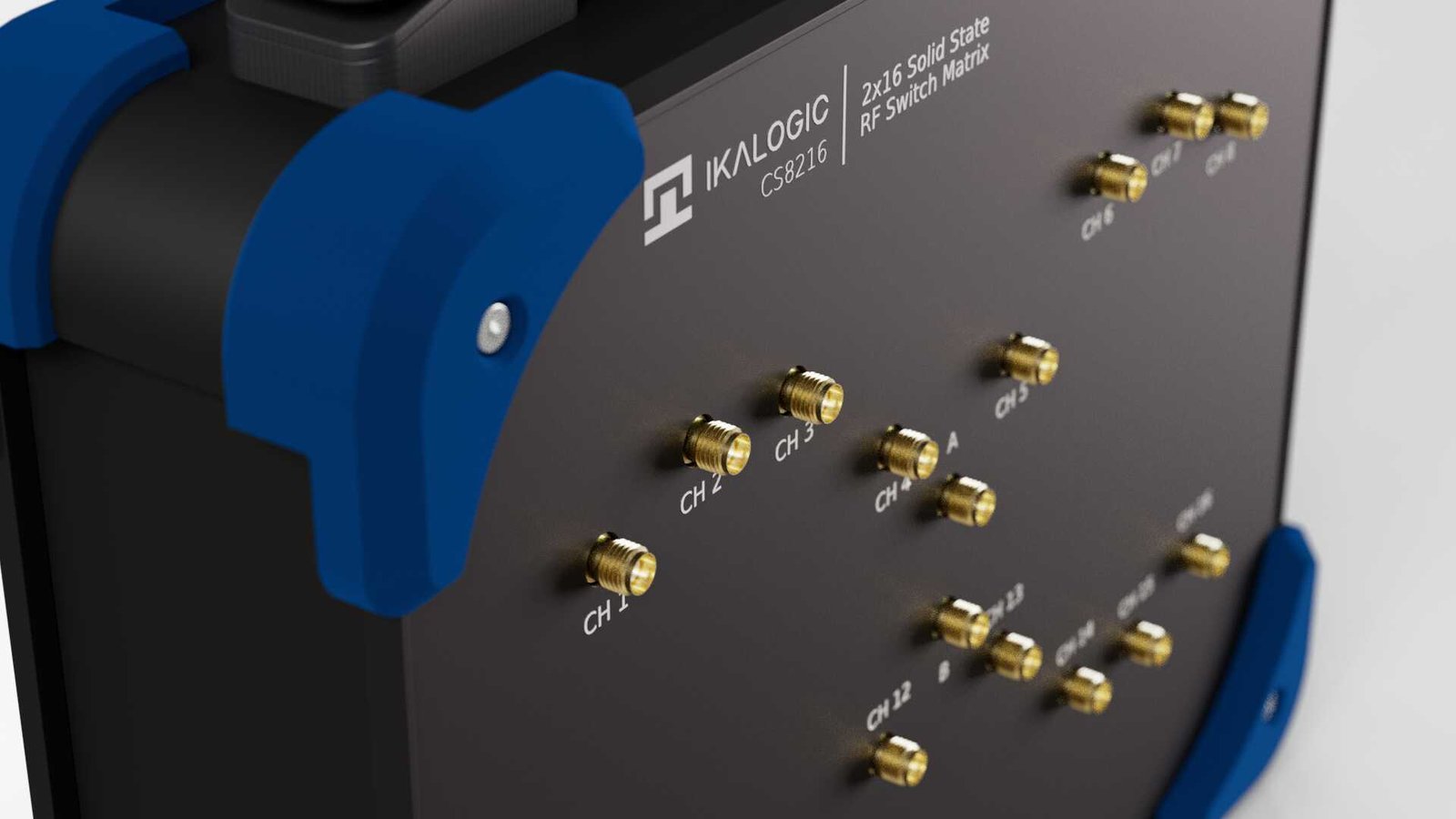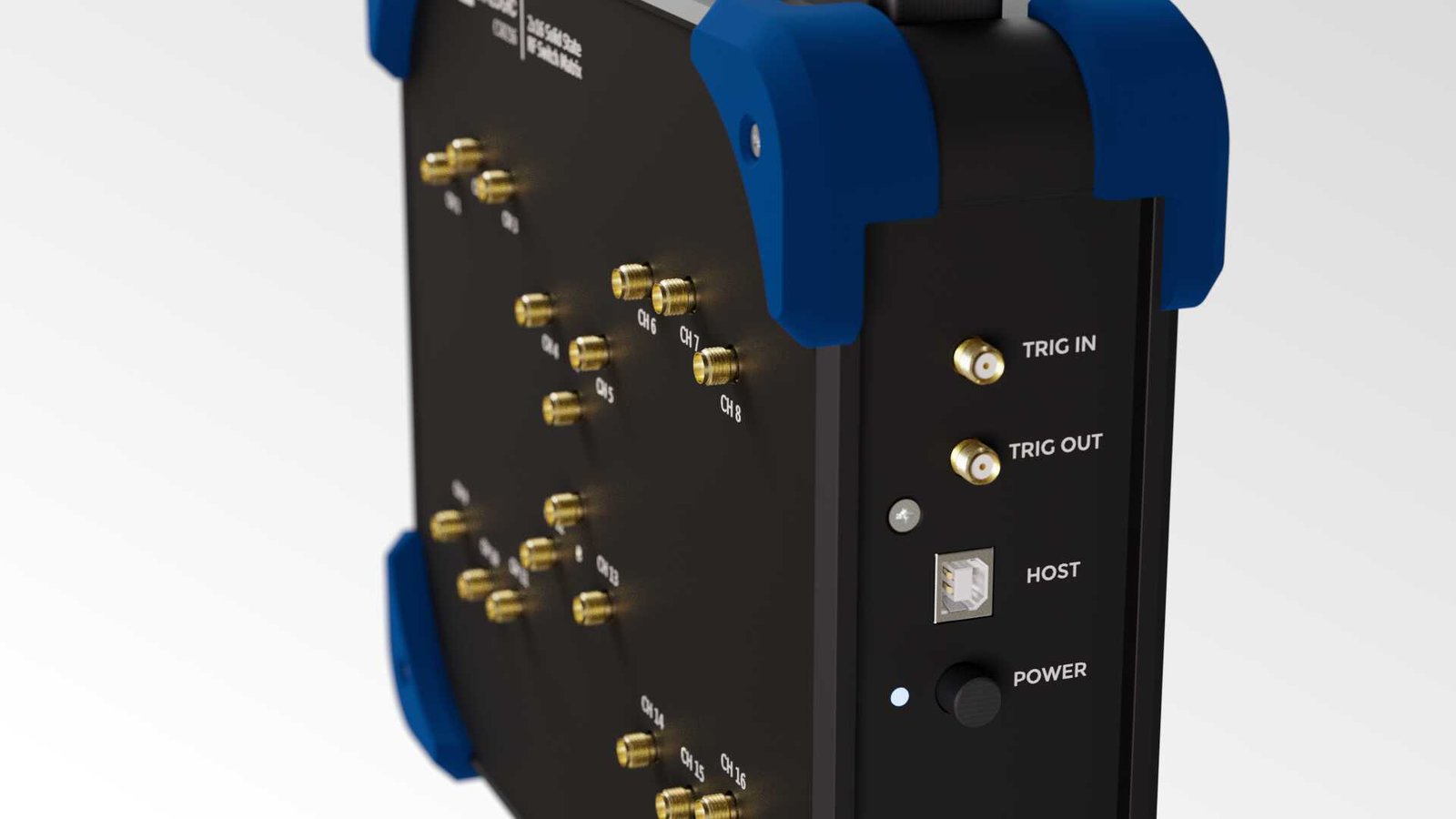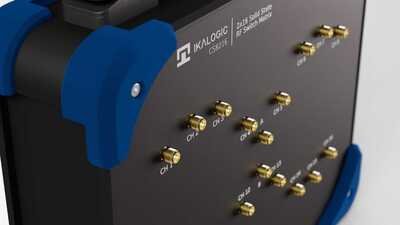CS8216 RF Switch Matrix
Low insertion-loss, high isolation 2x16 RF signal routing with Python and NodeJS APIs
The CS8216 RF Switch Matrix (Part of CS8000 Family) offers an array of 2x16 RF signal routing for automated test equipment, production testing, and R&D applications (5G MIMO, IoT device testing, Multi-channel VNA setups, etc.). CS8216 connects to a computer (Windows, Linux, MacOS) via USB and is controlled through an intuitive GUI software or programmatically using a comprehensive API supporting Python and NodeJS.
- RF Signal Routing
- CS8000 SwitchMaster
- Fast switching
- Advanced Control
- API Oriented
Route RF signals between multiple sources and destinations with low insertion loss and high isolation.
The CS8216 provides best-in-class switching performance, with typical figures of -5dB insertion loss at 4GHz and isolation better than 70dB. This makes it ideal for applications requiring precise signal routing while maintaining signal integrity.
Start testing in seconds with a intuitive, easy to learn CS8000 SwitchMaster software
A powerful instrument is nothing without a powerfull software. CS8000 SwitchMaster completes the CS8216 RF Switch Matrix by providing an intuitive graphical user interface for manual control, as well as advanced features for loading complex test sequences. Download SwitchMaster software and try in demo-mode
Solid-state at its best: experience rapid switching speeds ideal for automated applications.
The CS8216 is engineered for demanding application where rapid switching and low settling times are key. Unlike mechanical switches, CS8216 solid-state design ensures 0 wear, sub 1µs switching times, providing reliable performance over millions of switching cycles.

Build, load and launch a switching sequence with precise timing and control.
Trigger input and Trigger output signals allow synchronization with external test equipment, enabling complex test sequences and automated workflows.

Built from the ground up for automation.
The CS8216 supports fully automated operation through its API and scripting capabilities. Create custom test sequences, automate switch configurations, and integrate with test automation frameworks. Perfect for production testing environments where speed and repeatability are essential.
Learn more about API// Example JS code to control CS8216
import { CS8000 } from "@ikalogic/cs8000-api";
const sw = new CS8000("CS8216");
sw.open();
sw.prepare(1, 5); //prepare to connect COM A -> 5
sw.prepare(2, 10); //prepare to connect COM B -> 10
sw.commit(); //apply the prepared connections
Try CS8000 SWITCHMASTER app now
Yes, right here, right now, just click "start sequence" button!
Connection Preview
Switching Sequence
| Step | COM A | COM B | Actions |
|---|---|---|---|
| 1 | CH 5 | CH 15 | |
| 2 | CH 13 | CH 14 | |
| 3 | CH 1 | CH 13 | |
| 4 | CH 5 | CH 6 | |
| 5 | CH 9 | CH 7 | |
| 6 | CH 16 | CH 1 | |
| 7 | CH 4 | CH 5 |
Loop Mode:
Ready to control a real CS8216 device?
Download SwitchMaster software to work with a real deviceCS8000 Series
CS8000 series of RF Switch Matrices will be expanded to cover diverse channel counts and configuration. The first model in the series, the CS8216, offers a 2x16 matrix configuration and is available for order now.

CS8216
- 2x16 RF switch matrix
- 100MHz - 8GHz operation
- Low insertion loss & high isolation
- USB control interface
- Trigger based synchronization
- Comprehensive API support
Applications
- Automated Test Equipment (ATE): Integrate RF switching into production test systems
- Semiconductor Testing: Route RF signals during IC validation and production testing
- Component Testing: Test RF components across multiple configurations
- R&D Applications: Flexible signal routing for research and development
- Production Testing: High-throughput testing with automated switch control
- Signal Distribution: Route signals between multiple test points
- Multi-Path Testing: Enable complex test configurations with minimal setup
- System Integration: Connect multiple RF instruments and DUTs efficiently
Benefits
- Automate RF test setups with programmable switch control
- Reduce test time with fast switching and automated operation
- Maintain signal integrity with excellent RF performance
- Integrate easily with existing test equipment and software
- Scale test capabilities with flexible matrix configurations
- Improve repeatability with saved switch configurations
- Reduce manual errors through automated test sequences
- Lower cost of test by optimizing equipment utilization
Frequently Asked Question
Why is the connectors arranged in such a specific way?
The connector layout is dictated by the internal routing constraints of the RF switch matrix. Among other factors, this connector arrangements allows optimal isolation between channels, and minimizes the channel-to-channel phase variations.
Can I control multiple CS8216 units simultaneously?
Absolutely. Each CS8000 device have a unique serial number, allowing multiple units to be connected and controlled independently from the same host computer. The API supports managing multiple devices, enabling complex test setups involving several RF switch matrices.
What is the usage of Trig-IN and Trig-OUT ports?
Trigger OUT fires a 10us pulse when a connection is established. The rising edge of that pulse is perfectly synchronized to the instant where the switch closes and signal transfer reaches 90%. Trig-IN is used in sequence mode: a rising edge on Trig-IN allows the switch to move on to the next step in a sequence.
Trigger SMA ports are optional. If you only need to set a connection (say, connect COM A to channel 15), you don't need to worry about trigger ports.
Can I control the switch without API programming
Yes. For that you need to download the CS8000-SwitchMaster application, which will offer you the same features set as the API.
If you need to integrate the CS8000 switch into a automated system (MatLab, Octave, Labview, or any other framework), please contact us.
Can I save and recall switch configurations?
Yes, the CS8216 control software support configuration management features including saving, loading, and managing multiple switch configurations. This enables repeatable test setups and quick reconfiguration for different test scenarios, improving efficiency in both manual and automated operations.